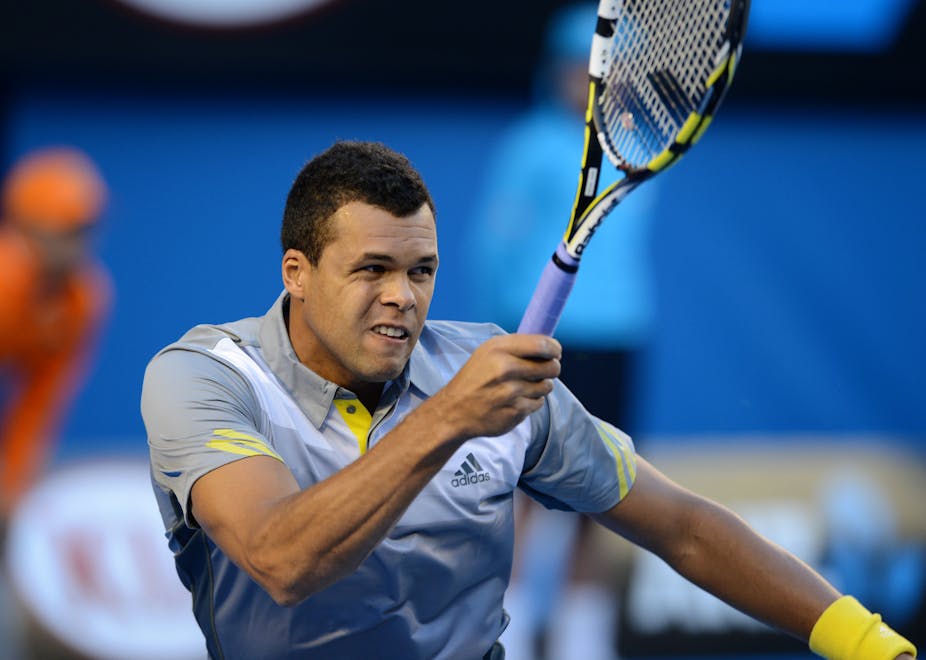Two interesting and intersecting events occurred at the Australian Open this week. First, Frenchman Jo-Wilfried Tsonga questioned women’s ability to control their emotions while playing tennis at a press conference.
The following day, world number one Victoria Azarenka won her semi-final match in controversial circumstances when she took two medical timeouts late in the second set of her Australian Open semi-final clash with US teen Sloane Stephens. In her post-match on-court interview, Azarenka seemed to suggest that she had panicked and needed the medical timeouts to pull herself together. While she later retreated from this explanation, the damage was already done to her and to women’s tennis.
Azarenka’s actions have been described by Stephens’ coach and a raft of former professional players as “cheating within the rules” and “unsportsmanlike”. One article said she should be disqualified. Although Australian Open management later confirmed that Azarenka was indeed treated for two separate injuries during the medical timeouts, this did not stop critics from basically accusing her of cheating.
After his loss to Swiss maestro Roger Federer in the men’s quarter final, world number eight Jo-Wilfried Tsonga was asked why there is not a similar dominance of a handful of women in the sport. Although the question is factually incorrect (there are a dominant few women on the professional women’s tennis circuit), it gave Tsonga a forum for his chauvinistic views.

Tsonga explained that the reason men dominate is because women are more emotionally unstable than men. “I’m sure everybody will say it’s true, even the girls”, he said. “I mean, it’s just about hormones and all this stuff. We don’t have all these bad things so we are physically in a good shape every time and you are not.”
In saying this, Tsonga essentially attributed what he perceives to be women’s uneven performance with the menstrual cycle, reinforcing the stereotype that women are overly emotional and prone to breakdown under pressure due to their biological make-up. They can’t help it in his view, and because of that they will never be able to match the men. Regretfully, Azarenka’s initial confession that she choked and felt the onset of panic during her match with Stephens reinforces these negative stereotypes even though the highest ranked female tennis player in the world eventually made her way into Saturday’s final, where she will seek to defend her title.
Tsonga’s comments highlight ongoing questions about women in professional tennis.
First of all, it is debatable whether there has not been a similar dominance of a small number of top players in the women’s singles, historically and at present. What about all-time greats such as Steffi Graf (22 Grand Slams), Martina Navratilova (18 Grand Slams), Serena Williams (15 Grand Slams) and Monica Seles (9 Grand Slams)?
There is compelling evidence that the prevailing belief that men’s tennis is currently highly predictable and less competitive than women’s tennis is false when we look at the entire tours. Economist Liam Lenten calculated that overall, men’s tennis is actually (slightly) more competitive than women’s tennis in terms of the percentage of matches that go to the deciding set, the likelihood of upsets, and so forth.
But even if casual observers of the game find women’s tennis less predictable and more competitive than men’s, it follows that women’s tennis would offer a more balanced and interesting proposition to watch. Indeed, it would mean that women’s tennis has a greater element of uncertainty which, as former cricketer Ed Smith vividly argues in his book Luck, is a key ingredient of a game’s popularity. Why, then, does women’s tennis have smaller television audiences and fewer fans and sponsors than men’s tennis?

The answer, unfortunately, is quite simple: sexism. The portrayal of women as emotionally unstable feeds into deeply rooted stereotypes regarding biological difference and how this affects performance in sports. The gendered nature of sport is not just cultural, but structural - it is structured by codified rules of segregation. In fact, sport is one of the most segregated institutions in western societies.
Tennis is a prime example of a sport with profound gender segregation, especially at the competitive level. The entire elite level (apart from the mixed doubles) is separated by gender - the ATP World Tour for men and the Women’s Tennis Association (WTA) for women. Why this is the case seems obvious: men are physically stronger and faster than women, and therefore it would be unfair for them to compete against each other. But this belief seems to justify the positioning of women’s sport below men’s in terms of funding, media attention and general esteem. The gender divisions in sport are reinforced by patriarchal beliefs about the value and capacity of women.
A striking example of this was an article by Fairfax journalist Richard Hinds who drew on what he perceived as Azarenka’s meltdown to denigrate women’s tennis. In his article he likened women’s tennis players to prostitutes, writing:
Why pay for a sensory experience you can get for nothing standing outside an opened window at a brothel?
The real challenge will be to address these deeper sources of unfairness by challenging conventional perceptions of tennis as a “gentleman’s sport”. Of all professional sports, tennis is the main one where women are prominently featured. Women’s tennis is covered on prime time television, and in the Grand Slam tournaments there is gender equity in the prize pool. But as long as erroneous beliefs about women’s hormones continue to shape our reviews of the women’s game, women’s tennis will continually strive for the recognition it deserves.

